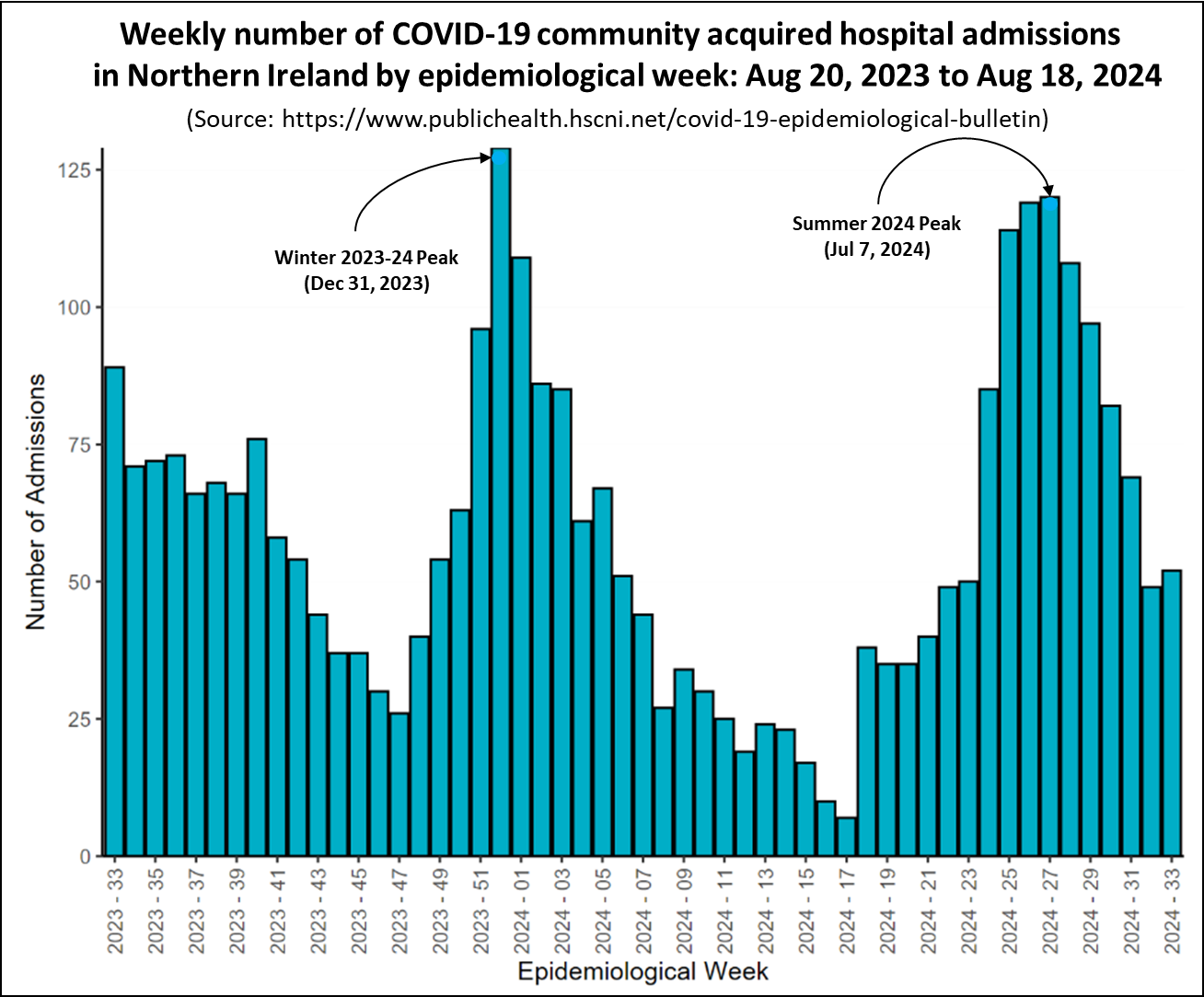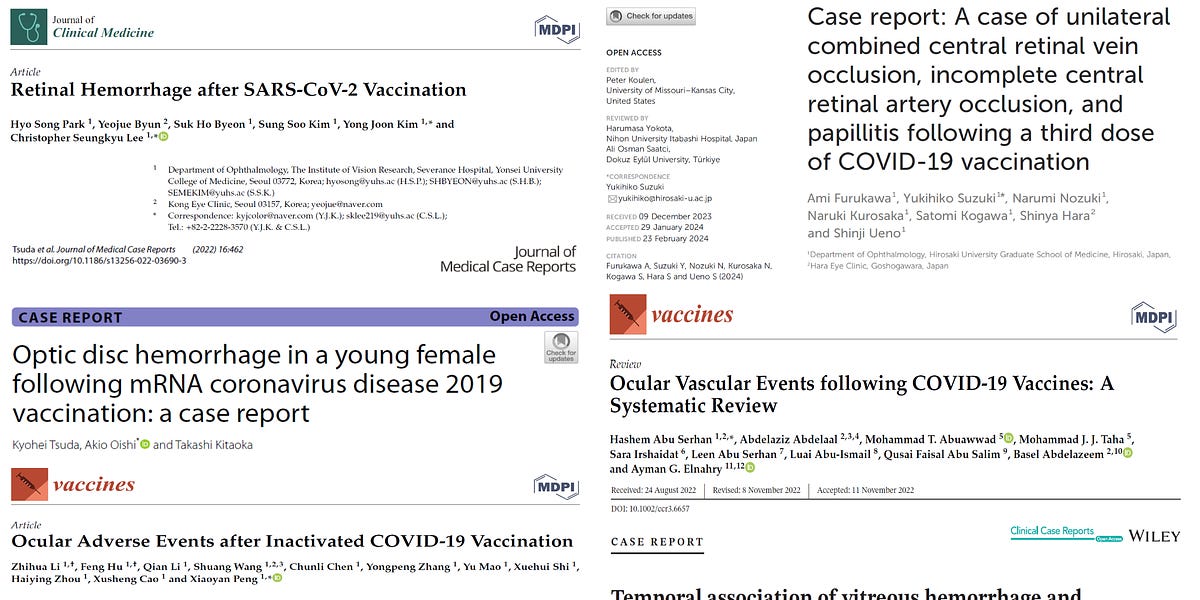Navigation
Install the app
How to install the app on iOS
Follow along with the video below to see how to install our site as a web app on your home screen.
Note: This feature may not be available in some browsers.
More options
Style variation
You are using an out of date browser. It may not display this or other websites correctly.
You should upgrade or use an alternative browser.
You should upgrade or use an alternative browser.
Covid-19 News and Discussions
- Thread starter Yommie
- Start date
Yommie
Elite Member
- Oct 2, 2013
- 64,004
- 37,183
- Country of Origin

- Country of Residence

- Thread starter
- #1,917

Covid Situation Report: Aug 22, 2024
Update on Covid providing information on prevalence and hospital admissions for England and its regions. This post is best viewed using the browser or Substack app.
Covid Situation Report: Aug 22, 2024
Update on Covid providing information on prevalence and hospital admissions for England and its regions. This post is best viewed using the browser or Substack app.

Bob Hawkins
Aug 22, 2024
12
5
2
Share
Introduction.
This report is part of a weekly series that summarises the Covid situation in England and its regions.A reminder that not all of the data previously included in the situation update is now available on a weekly basis. Where relevant, changes to the content and data sources have been noted.
This week the data published for England only covers case rates from the UKHSA Covid dashboard. As data for England is limited, I have also included the latest available data for Scotland, Wales and Northern Ireland. Finally, I provide an update on Covid deaths in England and Wales.
Summary.
Recent data for England, Scotland, Wales, and Northern Ireland show a continuing decline in Covid levels, indicating the end of the latest wave.Over the past week, daily case rates in England decreased again, signalling that the July wave is over. Case rates have fell across all regions .
In Scotland, hospital admissions and the number of beds occupied by Covid patients continue their rapid fall following the summer peak.
Wales has seen a continued decrease in Covid cases and hospital admissions, indicating the end of the recent wave.
Northern Ireland is experiencing a similar trend, with hospital admissions for community-acquired Covid consistently declining from the latest peak.
The recent increase in cases and hospital admissions has led to a rise in deaths due to Covid in England and Wales, albeit they continue to be at relatively low levels.
Although the data indicates that this recent wave is over, this is an important reminder that Covid is not presently a seasonal disease and may never become one. As such, we should anticipate potential future waves with the emergence of new variants and as immunity levels diminish.
As always, it’s important to remember that the risk of hospitalisation from Covid infection increases significantly with age and for those immunocompromised. Also Long Covid remains a risk for all as shown by the recent ONS report. Therefore, it is prudent to take appropriate measures such as self-isolating when experiencing Covid symptoms and enhancing ventilation or wearing masks whenever possible.
For those who are interested, I recently published an article covering the ONS data on Long Covid in more detail which can be found here. Also a comprehensive review of the evidence in support of wearing masks is available here.
Status of main respiratory diseases in England.
The UKHSA National influenza and COVID-19 surveillance report has moved to a condensed summer report and is now released every two weeks. Consequently, there is no updated information on Covid test positivity or weekly hospital admissions available to report. The next update will be published on Thursday, August 29.
Covid case rates in England
The UKHSA Covid dashboard continues to publish daily case rates for England on a weekly basis. As the majority of testing now occurs in hospitals or under medical supervision, these rates should closely align with hospital admissions. However, a comparison of daily case rates and daily admissions shows that this is not the case.Appendix 1 indicates that although Covid case rates typically reflect the pattern of hospital admissions, there is a notable discrepancy in the magnitude of changes, with admissions experiencing a more pronounced fluctuation than case rates. Therefore, while case rates are helpful in signalling the general trend of Covid within the population, they do not precisely represent the degree of change.
The first chart in this section shows daily case rate per 100,000 individuals.
The chart indicates that Covid case rates have peaked and have fallen significantly for the past four weeks indicating that the ‘summer’ wave is over. Current case rates are now lower than those observed during the peak in May and are approaching the lower levels seen in the spring. It is important to note, as detailed above and in Appendix 1, that comparisons with the peak in Winter 2023 are not recommended.
The next panel chart in this section shows Covid rates for the regions of England. Hover your cursor over one of the chart lines to display the admission rates for all regions.
The panel charts indicate that daily case rates are continuing to decline in all regions, Despite the recent significant falls, the North East region still reports a case rate that is higher than any other area.
Daily Covid hospital admissions and bed occupancy.
This section gives a more detailed examination of the most recent daily Covid data for hospitals in England.NHS England stopped the weekly publication of data used to create these dashboards from April 4, 2024 and have moved to a monthly publication schedule. The next update will be available on September 12, 2024 covering August data.
Scotland weekly hospital admissions and bed occupancy
Scotland continues to publish weekly data on hospital admissions and bed occupancy for Covid as well as waste water monitoring data. The dashboard for Scotland’s data can be accessed here.The following panel chart shows the most recent data for weekly Covid hospital admissions up to Aug 11, depicted in blue, together with the number of beds occupied by Covid patients up to Aug 18, shown in orange. The number of occupied beds represent patients being treated for Covid as well as those being treated with Covid.
The charts shows that the recent 'summer' Covid wave in Scotland has led to more hospital admissions and a greater number of beds occupied by Covid patients compared to the 'winter' wave. This contrasts with England, where 'summer' hospital admissions did not surpass those seen in 'winter'.
However, in the past five weeks Covid admissions and bed occupancy in Scotland have fallen rapidly and this ‘summer’ wave is over.
Finally, although Scotland remains the only home nation that is monitoring Covid levels using wastewater sampling, there was no update to the data provided this week.
Wales Covid cases and hospital admissions.
Public Health Wales publishes a weekly Covid dashboard, presenting key Covid hospital indicators for the preceding 90 days. This dashboard can be found here. Additionally, data regarding Covid cases detected through testing in hospitals and other medical facilities are released every week.The following charts shows the latest data for the weekly (7 day rolling sum) number of cases reported.
The chart shows that Covid cases in Wales are declining rapidly, nearing the levels seen prior to the recent surge, indicating that the summer wave is over.
Data regarding Covid hospital admissions in Wales is published for the most recent 90-day period, and the following chart gives the current trend.
Hospital admissions for Covid increased in June, but have now plateaued after falling significantly for the previous four weeks, mirroring the trend observed in Covid cases, and confirming that the ‘summer’ wave is likely over.
Northern Ireland hospital admissions
Public Health Northern Ireland publishes a weekly COVID-19 Epidemiological Bulletin that provides data on Covid cases, hospital admissions and occupancy and care home incidents. The full report, published every Thursday, can be found here.The chart below presents the weekly count of Covid hospital admissions for cases where the infection was contracted in the community, thereby excluding patients who contracted Covid while in hospital. Note that hospital admissions data for the other home nations do include patients who were infected in hospital so should not be compared to the data for Northern Ireland.

The chart shows a similar pattern to that seen in Scotland Wales, with the 'summer' wave's peak nearly reaching the heights of the 'winter' wave. However, a decline in admissions over the past six weeks suggests that the 'summer' wave is over.
Covid Deaths in England and Wales
The Office of National Statistics (ONS) publishes weekly reports on the number of deaths recorded on death certificates that are due to Covid or where Covid was involved. The data available is for both England and Wales. The following chart compares the number of deaths due to Covid in England and Wales by the week of registration for 2023-24 with the previous 12 months. The chart does not include deaths where Covid was identified as a contributing cause on the death certificate.The chart indicates that for the eighth consecutive week, deaths due to Covid in England and Wales are currently higher than the figures reported for the same period a year ago. This increase is attributed to the recent summer wave, which saw case rates and hospital admissions significantly surpass those in the summer of 2023.
However, despite these recent increases, the weekly death toll from Covid in 2023/24 has seen a substantial decrease from the previous year. In the 12 months leading up to August 9, 2024, there were 6,763 deaths reported, compared to 13,539 deaths in the previous 12-month period — a 50% reduction.
In conclusion
Although the amount of data currently being published has decreased, the limited information available for England indicates that Covid levels continue to fall and the ‘summer’ wave is close to being over.Data from Scotland, Wales, and Northern Ireland shows that the recent 'summer' wave of Covid saw higher levels than the 'winter' wave. Nevertheless, the most recent figures show sustained falls in Covid levels indicating that this surge has ended.
Finally, deaths due to Covid have increases in England and Wales as a result of the recent surge in Covid levels, although they remains at relatively low levels
As always, if you have any comments on this Covid Situation Report or suggestions for topics to cover, please post a message below.
Subscribed
Appendix 1. How reliable are Daily Covid Case Rates?
The UKHSA Covid dashboard continues to publish daily case rates for England on a weekly basis. As the majority of testing now occurs in hospitals or under medical supervision, these rates should be closely aligned with hospital admissions and the positivity rate of tests.The first panel chart in this section tests that assumption by comparing the daily case rate per 100,000 individuals, shown in red, with daily hospital admissions for Covid reported by NHS England, depicted in blue.
The chart shows that while Covid case rates generally mirror the pattern of Covid hospital admissions, there is a significant disparity in the scale of changes. The grey shaded areas on each chart highlights the difference between the peak of the winter wave and the recent peak in June. Case rates experienced a 64% decrease, whereas hospital admissions saw a reduction of only 32% between the winter and June peaks.
In conclusion, although case rates are useful for indicating the overall trend of Covid in the population, they do not accurately reflect the extent of change. The likely reason for this is that testing levels have decreased by about a half since January.
Yommie
Elite Member
- Oct 2, 2013
- 64,004
- 37,183
- Country of Origin

- Country of Residence

- Thread starter
- #1,918
@Sharma Ji

 lionessofjudah.substack.com
lionessofjudah.substack.com

Were Unvaccinated People TARGETED and MURDERED by Hospitals During COVID?
Remdesivir, ventilators, drug cocktails — these and others are increasingly being called parts of the “hospital murder protocol.”
Yommie
Elite Member
- Oct 2, 2013
- 64,004
- 37,183
- Country of Origin

- Country of Residence

- Thread starter
- #1,919

Ocular Hemorrhage Attributed to COVID-19 Vaccination
Risk Factors Include Diabetes, Prior Eye Surgery, and Ocular Injections but Not Oral Anticoagulants
Ocular Hemorrhage Attributed to COVID-19 Vaccination
Risk Factors Include Diabetes, Prior Eye Surgery, and Ocular Injections but Not Oral Anticoagulants

Peter A. McCullough, MD, MPH
Aug 22, 2024
129
13
Share
Article voiceover
1×
0:00
-1:49By Peter A. McCullough, MD, MPH
In clinical practice I have seen a range of ocular pathologies in patients after COVID-19 vaccination and confirmed findings with ophthalmologists. One thing I have learned is that the Spike protein from COVID-19 vaccination can cause a wide array of both bleeding and clotting abnormalities long after injection. This may be worsened by intercurrent COVID-19 illness. Because of the widespread use of fibrinolytic and anticoagulant supplements (nattokinase, bromelain) and medicinal antiplatelet and anticoagulant drugs (aspirin, clopidogrel, apixaban, rivaroxaban, dabigatran, warfarin), I wondered if use of these agents was worsening the risk of bleeding in the eye among the vaccinated.

I found numerous reports of ocular hemorrhage after COVID-19 vaccination. Diabetes, prior cataract surgery, and injections for macular degeneration were cited as risk factors or co-incident conditions. It was interesting that not a single report cited an over-the-counter or prescription blood thinner as a contributing factor.
While all supplements and drugs have risks and benefits, I believe our usual and customary practice of warning patients concerning mucosal and major bleeding is reasonable. The risks of clotting after vaccination far outweigh the risks of bleeding, and thus I will continue to recommend anticoagulant regimens in the appropriate clinical scenarios with bleeding caveats given to patients.
Yommie
Elite Member
- Oct 2, 2013
- 64,004
- 37,183
- Country of Origin

- Country of Residence

- Thread starter
- #1,920
COVID outbreak declared at Guelph General Hospital
Hospital says 2 patients contracted COVID during their stay in the facility
CBC News · Posted: Aug 22, 2024 4:40 PM EDT | Last Updated: 2 hours ago
Guelph General Hospital has declared a COVID outbreak on Aug. 22, 2024. (Paula Duhatschek/CBC)
Social Sharing
- X
A release sent out Thursday said the outbreak is confined to the hospital's 4 East unit.
Several steps have been taken to reduce spread of the virus, including "putting all patients in the unit in appropriate additional precautions, COVID testing of all patients in the unit, closing the unit to visitors except for compassionate grounds and increasing the cleaning being done including frequent cleaning of high touch and high traffic areas," the release said.
The outbreak was declared in consultation with Wellington-Dufferin-Guelph Public Health.
New masking rules at hospital
Following an outbreak earlier in the month, the hospital enacted new masking rules.Masks are required in clinical areas of the hospital, such as nursing stations, patient rooms and waiting rooms. Since the requirements are in the first phase, masks are not required in non-clinical areas.
The hospital has masking stations at entrances and nursing stations.
Users who are viewing this thread
Total: 3 (members: 0, guests: 3)
Pakistan Defence Latest
-
Pakistan’s first multi-mission satellite, PAKSAT-MM1, becomes operational (6 Viewers)
- Latest: Jf Thunder
-
-
-
-
Country Watch Latest
Latest Posts
-
Grounded flight school student being held on no bond after vandalizing planes (6 Viewers)
- Latest: Dalit
-
-
-
Pakistan’s first multi-mission satellite, PAKSAT-MM1, becomes operational (6 Viewers)
- Latest: Jf Thunder
